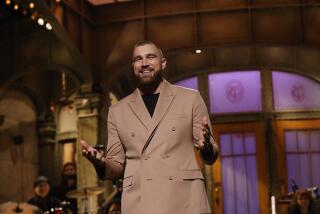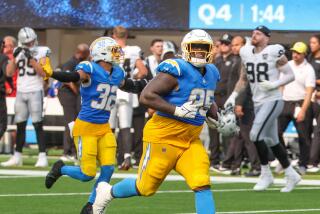PRO FOOTBALL ’95 : The BIG Picture : On the Field, Those 300-Pounders Look Large Enough, but Off the Field, They Face a Different World
- Share via
For three hours every Sunday, he is a giant.
Cameras isolate his surprisingly quick movements. Fans revel in a clunky but lovable celebration dance. John Madden awards him turkey legs on Thanksgiving.
Then the stadium empties, the uniform is peeled off and he makes a painfully slow walk to a car in a dimly lighted parking lot.
The illusion of greatness becomes the reality at the end of another workday.
The giant becomes a fat guy.
“On the field, it’s, ‘Boy, that guy is big ,” said Louie Kelcher, one of the original 300-pound NFL defensive linemen. “Then they step into the real world and it’s, ‘Oh, look, a fat guy.’ ”
He walks into his house and sits on a custom-made bed that is still too short.
He hangs his clothes in a closet full of overpriced clothes that could double as painters’ dropcloths.
He hugs a wife who once admitted to a fear of intimacy.
“Have you ever thought about sleeping with a guy who weighed 300 pounds?” she asked.
He eats a normal dinner of chicken and rice, but by 10 p.m. is hungry again. So he eats another one.
Before going to sleep, he peeks at his three young children and sighs.
If he doesn’t lose weight, he will be dead before they graduate from high school.
But he can’t.
Because in 12 hours he will be back on the football field, underneath a helmet and in his glory.
In 12 hours, he will be a giant again.
*
When tackle Jerry Crafts goes clothes shopping, his first stop is women’s lingerie.
It’s where he buys his T-shirts.
“I buy women’s nightshirts, wash them once, and they fit perfect,” Crafts, a 6-foot-6, 360-pound tackle, said during a recent break at the Green Bay Packers’ training camp.
“OK, so the shirts don’t always look so great,” he said. “When you’re this size, you don’t care what it looks like or what color it is.”
Guard Bernard Dafney of the Minnesota Vikings never travels anywhere by car unless he knows exactly where he is going.
He knows a 6-foot-5, 331-pound man cannot simply pop out of a front seat at a gas station and ask for directions.
“People are so scared of me,” he said softly. “They see me walking toward them, they will tell me anything to get me going.”
Joe Phillips, defensive tackle for the Kansas City Chiefs, was thrilled the day he reported to his new law offices.
Until he saw that his desk was up on blocks.
“It was the only way they could make it big enough for me,” said Phillips, 6-5 and 300. “They even had to bring in a special thousand-pound chair.”
The world knows these big men as warriors. But the world forgets that the weight doesn’t come off with their shoulder pads.
A big man’s asset on the football field becomes his burden almost everywhere else.
“In this game, it’s a blessing to be big,” Crafts said. “But when you get into the real world, there are more negatives than positives.”
There will be more loads in the league than ever this year, as defenses counteract last year’s record-setting offenses, and offenses hold their ground.
On opening day Sunday, expect each 22-man starting lineup to include at least a few 300-pound men.
“It seems like the trend now is to get bigger people on both sides of the ball,” said Tom Donahoe, director of football operations for the Pittsburgh Steelers. “Everybody wants somebody who just cannot be pushed around.”
The Miami Dolphins got such great work from the two round guys in the center of their defensive line last year--Tim Bowens at 310 pounds and Chuck Klingbeil at 301--that they have become an AFC favorite.
The Cleveland Browns, another favorite, will counter with a splendid new offensive tackle who also happens to have a big belly, 325-pound Orlando Brown.
Perhaps most important among the stars of the San Francisco 49er defense is the man teammates jokingly call their fattest--defensive tackle Dana Stubblefield, at 6-2, 300 pounds.
And don’t forget the Dallas Cowboys and the man whose ability helped inspire the roly-poly revolution--6-3, 320-pound Nate Newton.
The Cowboys are so enamored of Newton’s size that they have kept grossly overweight guard Derek Kennard under contract even though Kennard--6-3, 365--has tried to quit.
What fans don’t see are the eating disorders.
They don’t see the players who induce diarrhea before mandatory weigh-ins.
They don’t see them trying to buy clothes. Or trying to impress potential off-season employers who reflect not interest but intimidation.
They don’t see the big guys in nice restaurants with their wives, when some little guy walks over, trying to act big.
Phillips remembers the time he was lunching with his wife at a trendy Kansas City eatery when a stranger walked over and said, “Hey buddy, let me arm-wrestle you. I’ll rip your arm right out of your socket.”
Phillips rolls his eyes at the recollection.
“I thought to myself, ‘Right, I really want want my arm out of my socket,’ ” he said. “I just looked at him.”
And fans don’t see big guys long after they have finished playing.
They don’t see what Kelcher, who played for the San Diego Chargers and 49ers from 1975-84, saw in that mirrored office building several years ago.
He was walking through downtown Austin, Tex., when he looked at the building and saw a person with a huge gut engulfing a huge belt.
He had gained 50 pounds in the eight years since his retirement.
“I thought, ‘Gawd almighty, I look like Shamu,’ ” Kelcher said. “I thought, ‘That’s disgusting.’
“When you are playing, you think you are invincible. Then reality hits you in the teeth.”
He has since lost the weight, fearing that he would not live to see his 3-year-old twins begin high school. But he is one of the lucky ones.
According to Elliott Pellman, an internist for the New York Jets, many heavy players face special problems when they retire.
Not only do they face the usual byproducts of obesity--hypertension, increased risk of heart disease--but they also have an increased chance of developing arthritis.
And many players, according to Pellman, cannot just quit and become thin.
“Often the large guys have eating disorders,” he said. “They eat like people with drinking problems drink.”
The only reason they are not bigger is that they are forced to exercise. When that motivation deteriorates, so does their health.
Because the league’s offensive and defensive lines have filled up with 300-pounders only in the last five years, scientists have yet to study the effects of obesity on former players.
Many of the players who are showered with cheers were once the object of derision among schoolmates. After all, they were the little fat kids. But football was always the large man’s revenge.
It took Dafney from Fremont High to Southwest Community College to Tennessee to the Viking starting lineup last year.
It took Crafts all the way from Metro Christian Academy in Tulsa to the Super Bowl with the Buffalo Bills.
“The same people who called me names are now investment bankers, calling me and asking for my money,” he said.
But big guys can never play by everybody else’s rules.
When Crafts arrives at the airport, he doesn’t check the flight schedule, but the flight boarding list.
If it’s a full flight, he’ll catch the next one. Or the next one.
“I’ve sat around two and three hours, just to get a flight where I can have some room to sit down,” he said.
And always, during the season the big guys have to work harder.
Crafts, who was once actually paid by a restaurant owner to walk away from a rapidly diminishing buffet, said, “I could get to 400 pounds in two days, 500 pounds in six months. Eating for me is that bad, that hard.”
When other players have closed their playbooks, big guys are poring over diet guides. When other players are watching TV, big guys are working rowing machines.
“When you get a big guy, you have to watch him all the time,” said Bob Ackles, director of football administration for the Philadelphia Eagles.
Big guys twist ankles easier than other players. They wrench more knees. They strain more backs.
And sometimes, big guys get too big.
Despite having appeared in every game for the Bills last season before signing a free-agent contract with the Packers, overweight Crafts was released at the end of training camp.
Despite having started every game for the Vikings last year, Dafney was recently put on injured reserve because of a twisted knee, then was cut.
“You know, I could go on David Letterman and do Stupid Human Tricks,” Crafts was saying earlier in camp, laughing. “A person can bounce four inches off my gut like it was a trampoline. I swear, I have it on film.”
He paused, and put down his shirt.
“Oh, I don’t know,” he said, suddenly softer. “Maybe not.”
(BEGIN TEXT OF INFOBOX / INFOGRAPHIC)
The NFL’s Top 10 Loads
1. Nate Newton, guard, Dallas Cowboys, 6 feet 3, 320 pounds.
Once said of defensive tackle William Perry, “If we rub up against each other the wrong way, we’ll start a grease fire.”
2. Keith Rucker, defensive tackle, Cincinnati Bengals, 6-4, 340.
While sitting in the visitors’ locker room before a game at Arizona last season, Rucker was handed a box of doughnuts with a note from Buddy Ryan.
3. Dwayne White, guard, St. Louis Rams, 6-2, 315.
Vomits when nervous, which perhaps accounts for the fact that nobody will stand next to him in the huddle.
4. Jerry Ball, defensive tackle, Oakland Raiders, 6-1, 315.
Once wrote a sports column for a newspaper in Detroit, a newsroom being one place where he is considered svelte.
5. Shawn Lee and Reuben Davis, defensive tackles, San Diego Chargers, combined 620 pounds.
Known around town as “Two Tons of Fun.”
6. Ray Seals, defensive end, Pittsburgh Steelers, 6-3, 309.
Spent the week before the AFC championship game trying to figure out how to dance on a Super Bowl rap video. No wonder he could barely move against the Chargers.
7. Gilbert Brown, defensive tackle, Green Bay Packers, 6-2, 330.
When asked to describe Brown’s size, Coach Mike Holmgren said he was, “a guy-and-a-half wide.”
8. Derek Kennard, guard, Cowboys, 6-3, 365.
Biggest rear end in professional sports. Attended a weight-loss clinic this summer and gained a few pounds.
9. Ian Beckles, guard, Tampa Bay Buccaneers, 6-1, 304.
Fattest French-speaking player in the league.
10. Roosevelt Potts, fullback, Indianapolis Colts, 6-0, 260.
Showed up in camp a couple of days late, at the same time 190-pound wide receiver Phil Anderson disappeared. Management announced that Anderson was waived, but it was widely rumored that Potts ate him.
Coach. Buddy Ryan, Arizona Cardinals.
The Sansabelt king.
More to Read
Go beyond the scoreboard
Get the latest on L.A.'s teams in the daily Sports Report newsletter.
You may occasionally receive promotional content from the Los Angeles Times.











